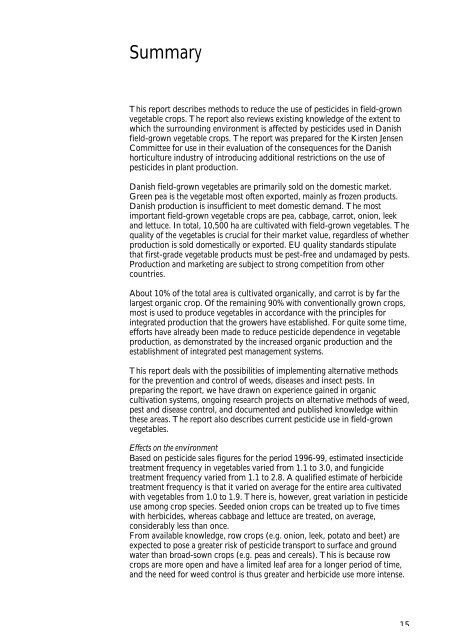You also want an ePaper? Increase the reach of your titles
YUMPU automatically turns print PDFs into web optimized ePapers that Google loves.
Summary<br />
This report describes methods to reduce the use of pesticides in field-grown<br />
vegetable crops. The report also reviews existing knowledge of the extent to<br />
which the surrounding environment is affected by pesticides used in Danish<br />
field-grown vegetable crops. The report was prepared for the Kirsten Jensen<br />
Committee for use in their evaluation of the consequences for the Danish<br />
horticulture industry of introducing additional restrictions on the use of<br />
pesticides in plant production.<br />
Danish field-grown vegetables are primarily sold on the domestic market.<br />
Green pea is the vegetable most often exported, mainly as frozen products.<br />
Danish production is insufficient to meet domestic demand. The most<br />
important field-grown vegetable crops are pea, cabbage, carrot, onion, leek<br />
and lettuce. In total, 10,500 ha are cultivated with field-grown vegetables. The<br />
quality of the vegetables is crucial for their market value, regardless of whether<br />
production is sold domestically or exported. EU quality standards stipulate<br />
that first-grade vegetable products must be pest-free and undamaged by pests.<br />
Production and marketing are subject to strong competition from other<br />
countries.<br />
About 10% of the total area is cultivated organically, and carrot is by far the<br />
largest organic crop. Of the remaining 90% with conventionally grown crops,<br />
most is used to produce vegetables in accordance with the principles for<br />
integrated production that the growers have established. For quite some time,<br />
efforts have already been made to reduce pesticide dependence in vegetable<br />
production, as demonstrated by the increased organic production and the<br />
establishment of integrated pest management systems.<br />
This report deals with the possibilities of implementing alternative methods<br />
for the prevention and control of weeds, diseases and insect pests. In<br />
preparing the report, we have drawn on experience gained in organic<br />
cultivation systems, ongoing research projects on alternative methods of weed,<br />
pest and disease control, and documented and published knowledge within<br />
these areas. The report also describes current pesticide use in field-grown<br />
vegetables.<br />
Effects on the environment<br />
Based on pesticide sales figures for the period 1996-99, estimated insecticide<br />
treatment frequency in vegetables varied from 1.1 to 3.0, and fungicide<br />
treatment frequency varied from 1.1 to 2.8. A qualified estimate of herbicide<br />
treatment frequency is that it varied on average for the entire area cultivated<br />
with vegetables from 1.0 to 1.9. There is, however, great variation in pesticide<br />
use among crop species. Seeded onion crops can be treated up to five times<br />
with herbicides, whereas cabbage and lettuce are treated, on average,<br />
considerably less than once.<br />
From available knowledge, row crops (e.g. onion, leek, potato and beet) are<br />
expected to pose a greater risk of pesticide transport to surface and ground<br />
water than broad-sown crops (e.g. peas and cereals). This is because row<br />
crops are more open and have a limited leaf area for a longer period of time,<br />
and the need for weed control is thus greater and herbicide use more intense.<br />
15

















